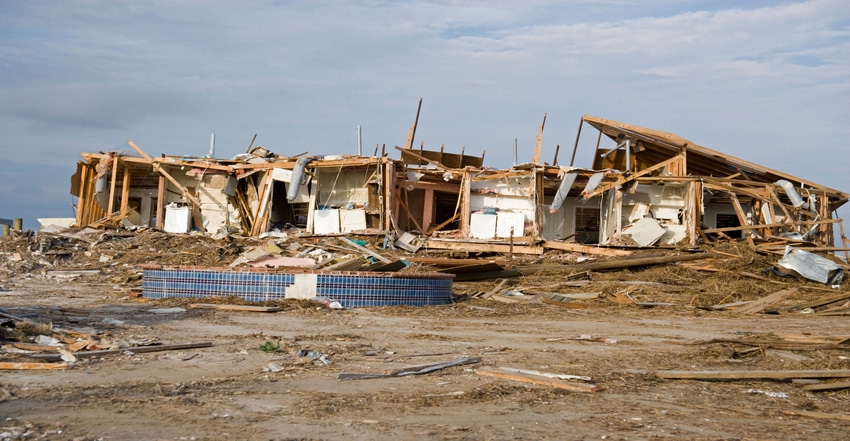Preparing a Construction Jobsite for a Hurricane
With hurricane season in full swing, here are the steps contractors on both coasts should take to secure their projects and keep staff safe.

With Hurricane Idalia barreling down on Florida, it’s critical for construction companies to plan how to keep jobsites secure and crews safe during a severe storm.
The official Atlantic basin hurricane season is June 1 to Nov. 30, with most activity taking place mid-August to mid-October, according to the National Oceanic and Atmospheric Administration. In early August, NOAA said there was “the likelihood of an above-normal Atlantic hurricane season,” predicting six to 11 hurricanes, with two to five of those being major.
The East Coast isn’t the only place construction companies need to be prepared. Earlier in August, Hilary, which was a hurricane over Mexico, hit Southern California as a tropical storm, the first in more than 80 years, causing floods, mudslides, high winds and power outages. A moderate earthquake shook a large portion of Southern California just hours after Hilary came ashore.
The following are steps construction companies can take to help protect their sites and people, according to reporting by our sister publication, Construction Dive:
1. Write a hurricane preparation plan.
It’s important that construction companies in hurricane-prone areas have a written hurricane preparation plan, whether it’s incredibly detailed or just a memo to assign everyone on the project a task to complete in advance of the storm.
2. Monitor the weather.
Monitor the weather on a regular basis, even when there is barely a threat. Online sites like the National Weather Service, The Weather Channel and Accuweather have the latest severe weather alerts posted almost immediately, so they are reliable sites to check.
Weather radios might be a worthwhile investment as well. These devices are configured to receive weather reports and are often equipped with alert capabilities that can be set to produce an audible alert if there is a severe weather event in store for the broadcast area. Another benefit: Many are powered by batteries, solar or even a hand crank to ensure a steady stream of weather information, even during power outages.
3. Work with local building departments.
In some areas, and especially for large projects, it’s not unusual for contractors to communicate with local building officials about their hurricane plans. Public safety is the stated mission for many building departments, and they often want reassurance that project sites pose no threat to neighboring properties or residents.
4. Secure jobsite materials.
When it looks like a storm will approach a project, it’s time for jobsite personnel to perform critical tasks, such as securing or removing materials, trash, tools or other items that can take flight in heavy winds. This includes dumpsters and portable bathrooms— he latter of which are typically made of lightweight fiberglass.
Items like fence screens and jobsite signage also must be removed, and any in-progress utility systems must be protected from sand or seawater intrusion if there is the possibility of storm surge. Now is also the time to remove any moveable electronics and project documents from the construction trailer and transport them to a safe location. Meanwhile, power to the site should be turned off, if possible, and fuel must be made available to power generators if there is no power post storm.
5. Plan for water removal.
Planning for water removal also is key. Many contractors place pumps in excavations or basements in advance of a storm so that pumping can begin as soon as it is safe. Getting rid of excess water is not only important for project cleanup but also to protect adjacent properties.
To discharge water safely and responsibly, it must be emptied onto the street so that the stormwater system can take it away. If the system is overwhelmed, it’s still important to get the excess water off the site, even if that means hiring a tanker truck to haul it away.
6. Secure hazardous chemicals.
Make sure that hazardous chemicals are removed or secured. If any of these chemicals could be released into the environment, contractors should have a third-party team ready to come in immediately after the storm to perform cleanup.
7. Ensure the structure’s security.
Now that the items on the project are secure, it’s time to safeguard the structure. If the work is a renovation—or has progressed on a new building to a point where water can significantly damage the interior—crews should board up openings and accessible windows and place sandbags around the perimeter.
8. Assess damage with a post-storm evaluation.
When the storm has passed and local authorities have given the go ahead, return to the project site to assess damage and start to clean up. It’s important to use caution when navigating every area—especially those with standing water—as sharp or jagged debris could pose a danger.
It’s also essential to use the same care when entering a building after a storm because, depending on the extent of the damage, some structural elements could be compromised.
9. Consider all risks.
Besides preparing jobsites for the physical hazards associated with a severe storm, companies also should consider other factors, independent safety consultant Randy DeVaul told our sister publication, HR Dive, via email:
Financial hazards (prolonged shutdown, product risks, customer risks).
Emotional/mental hazards (to employees during and after the event).
Community hazards (infrastructure effects, debris).
Business considerations (pay, time off, closing or staying open during and after a storm).
Logistics considerations (loss of materials delivery, storage of materials/products, preparing equipment for shutdown and restart).
Technology considerations (safety and continuity of essential databases, records, servers, processes).
Supplier/materials considerations.
“Include a cross-functional team from leadership, HR, maintenance, safety, production, engineering, planning and security to ensure all needs are identified and addressed,” said DeVaul, who also advised establishing a timeline to address these needs, as they cannot all be dealt with simultaneously.
About the Author(s)
You May Also Like




